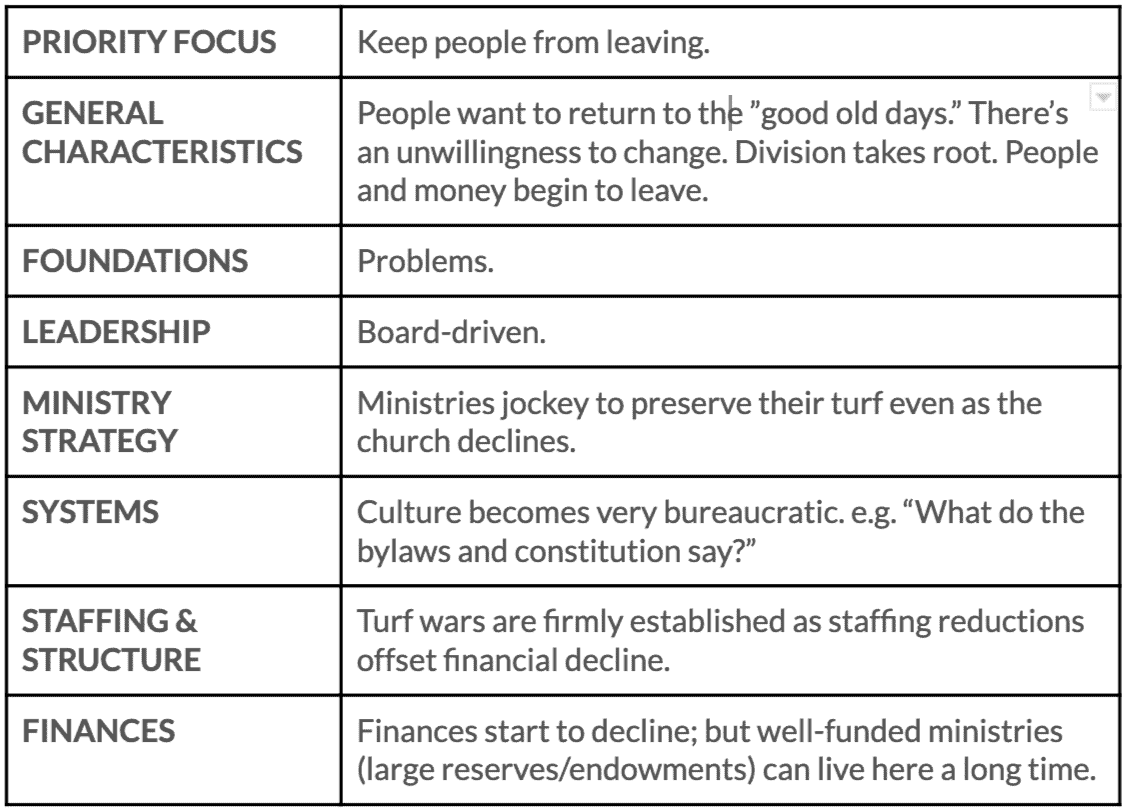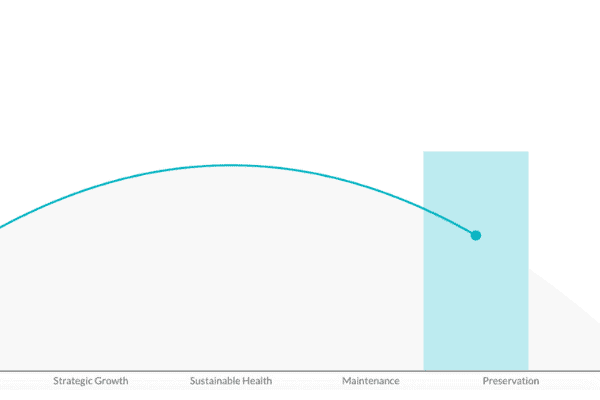By the time churches land in Preservation, it’s very difficult to turn things around. But don’t lose hope – it is possible.
In this season, the church is usually experiencing decline in both engagement and giving. The common solution is to try to reconnect with the people who have left. But what the church needs is fresh leadership and fresh vision.
We’ve worked with over 400 churches in the last ten years. Here’s what we typically see in Preservation phase churches:

NEXT STEPS
The most important thing to do in this season is hire a new leader, or empower a new approach to leadership, to implement a fresh vision and turnaround strategy.
-
Change Demands Intentional Leadership
You Can’t Keep Everyone Happy and Experience the Change That Produces Health at the Same Time
Most leaders believe if they lead well, everyone will stick with them. But the reality is you’ll lose people after each phase of implementing change, regardless of how well you lead. And change is essential to get out of Preservation. Prepare yourself for the journey ahead by understanding the cycles of change you will experience:
1. Cycle One: Create Urgency
The change cycle begins when the leader demonstrates the need for change. You create urgency by explaining why the change is necessary and why it can’t wait.
2. Cycle Two: Cast a Vision
This is the time for the change to be communicated to all levels of the organization. You have to connect the changes you are making to the mission and vision.
3. Cycle Three: Implement the Change
This is when leaders become leaders. Until this point, change has only been a conversation. Now it’s time for implementation. This is when courage is required.
4. Cycle Four: Celebrate Early Wins
Sharing quick wins will build morale and take away power from critics.
-
Address the Warning Signs First:
You Can’t Ignore Problems and Expect Them to Go Away
During our years of working with churches, we’ve found five common factors that contribute to major decline.
5 Attributes of Churches in Decline
- They Lack a Focused, Compelling Vision for the Future
- They Don’t Have a Clear Discipleship Path
- They Have an Inward Focus
- They Are Complex
- They Don’t Have Strong Leadership
Each of these are “warning lights” for churches. If one turns on, that should get your attention. If more than one is flashing, you have a problem. If all of them are lit up, it’s a crisis. You need to create and implement a turnaround strategy immediately.
-
Look Backward to Move Forward:
The Key to Health May Be in the Rearview Mirror
What vision shaped the early years? What values did the leadership embrace? How has the leadership, community, and culture shifted? What ministries had the biggest impact?
The practice of looking back isn’t to return to what the church used to do; it’s to return to who God wants the church to be.
-
Structure Boards for Health and Impact:
Move More People Into Ministry Over Meetings
Healthy, growing churches tend to have fewer boards and committees.
Churches with a complex governance structure typically lack unity and trust. We’ve seen it work best if churches only have one lay leadership board, usually about 5 to 9 people, and if the board is strategically focused on the big picture rather than the day-to-day.
Simplifying governance helps move more people out of meetings and into ministry.
-
Prioritize the Main Thing:
Adding More Events to the Calendar Will Not Produce Church Health
Churches tend to become very event-driven over time. Moving forward, when you are tempted to launch a new event, first ask, “If we were forced to do something other than an event, how might we help people take their next steps toward Christ?”
You might discover other options that could produce more fruit and require much smaller investments of time and resources than putting one more thing on the calendar.
A Comprehensive Guide to the Church Lifecycle
If your church is in Preservation, this is the time to get an outside perspective and expert guidance as you build a turnaround strategy. If you’d like to learn more about The Unstuck Process and how we help churches get unstuck and growing again, let’s talk.







Leave a Reply